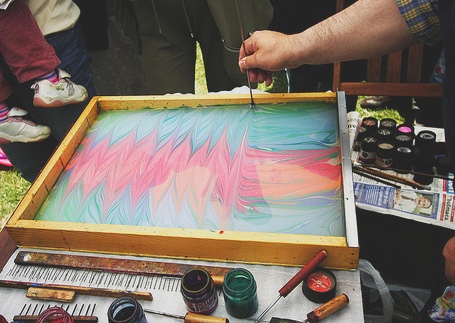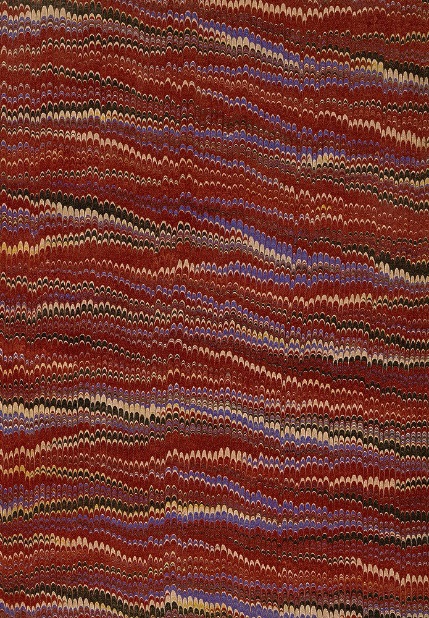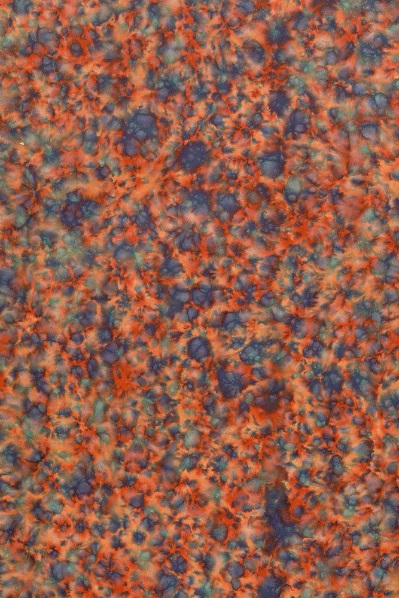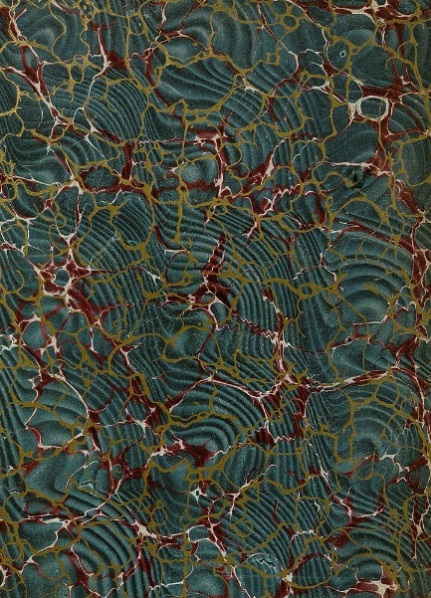When we think about submitting a piece of academic work/reserach, whether it is a PhD thesis, an essay or an article, standardisation always comes to mind. Formatting, referencing, and structuring are an integral part of academic writing and although most students dread the final adjustments, they are necessary. Most of us have been

Figure 1
Detail of a marbled endpaper
encouraged to use specific fonts, framing the page with xx margins, using formulaic headers. Personally, during my studies, I stayed away from unusual/somewhat artistic document structures and layouts, used the paper provided by the library’s printer and applied Cambria à gogo. I was required to provide both print and digital versions of my essays, but always followed the department guidelines. I did not think much of it. I understood that beautiful formatting was not necessary and might have cost me time and efforts.
Standardisation is a key component of essay writing but it was not so crucial in the past. Digitising theses from different decades of the 20th century, we have noticed how free the students were when it came to producing and printing their own work. Not all theses have acknowledgements, indexes, or even page numbers. They are printed on different sheets of papers, bound by different covers. Some early theses are of course, are handwritten and impossible therefore to ‘standardise’ But even with the spread of typewriters, homogeneity was hard to achieve; an Olivetti might have a different font from an IBM typewriter. Here at the Library Annexe, we have seen thesis bound in snakeskin leather, cardboard, and dealt with a lot of poor quality carbon copies. Authors seemed free to experiment with what suited them, what they found most aesthetically pleasing (and probably with what they could afford.).
Working in digitisation gives you the privilege of dealing closely with physical collections items, scrutinising them, handling physical objects every day, We have the opportunity to experience all the material that gets lost in the digital translation: the binding, the weight and sometimes the smell and texture of the book. After looking at hundreds of theses, spotting differences gets easy. One thing I love to keep my eye on is marbled endpapers (figures1,3,4,5).
Marbling is a printing technique that creates patterns similar to the ones naturally found in stone marble. In paper marbling, paint colours are transferred to a liquid surface, usually water or other adhesive solutions. With the help of chemicals, colours float on the surface and it is possible to manipulate them, creating different patters.Sheets of paper are the immersed into the liquid mixture (bath) .The patterns are then transferred into the paper. It creates monotype prints, so all marbled papers are unique works.
Paper marbling is widely used in bookbinding and has ancient origins. Scholars are in dispute on its birth place; Japan, China and Turkey have their own historical traditions of paper marbling. In Europe, marbling arrived in the Netherlands first, in the 17th-century.
So far, at the Annexe we have encountered beautiful marbled endpapers from the 20th-century. Most of them created by Edinburgh-based bookbinders. Figure 1 and 5 look very similar; they were probably created by the same bookbinder. He/she used the overprinting technique Overprinted papers have been ‘marbled’ twice, the first marbling transferred through bathing ; the second marbling is instead printed over the first one using a lithographic process.
Image x instead shows an example of nonpareil papers.
“This pattern is created when the desired colors are dropped sequentially onto the bath using some sort of implement to regulate the drop sizes. A comb with one set of teeth set at intervals of 15-30mm is drawn through the bath horizontally, once in either direction with the second pass halving the first. Then another comb with teeth set at 2-3 mm is drawn once across the bath vertically (or horizontally)”
Image 4 was most likely created using a piece of paper laid out on a flat surface coated with a color. Then marbling brushes would be used to sprinkle color directly onto the surface causing the characteristic spots of dispersed (bleeding) ink to be absorbed into the paper. This specific technique is called papier tourniquet.
These are only a few examples of end papers we have spotted in theses so far and I am sure there are more to come.When reading pdfs online we tend to leave bookbinding and all its artistry behind. As digitisers though, we have the opportunity to document what goes behind the scenes and bring to light what gets lost in the ‘translation’ from physical to digital.
More about paper marbling here:
Examples of a digitised collection of marble papers:
http://digitalcollections.lib.washington.edu/cdm/search/collection/dp
More on paper marbling technique can be found reading:





Fantastic post- Thanks Giulia!